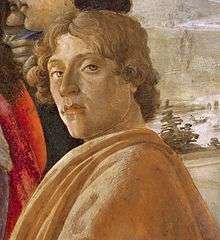Adoration of the Magi of 1475 (Botticelli)
_-_Uffizi.jpg) | |
| Artist | Sandro Botticelli |
|---|---|
| Year | c. 1475–1476 |
| Medium | Tempera on panel |
| Dimensions | 111 cm × 134 cm (44 in × 53 in) |
| Location | Uffizi, Florence |
The Adoration of the Magi is a painting by the Italian Renaissance master Sandro Botticelli, dating from 1475 or 1476. It is housed in the Uffizi of Florence. Botticelli was commissioned to paint at least seven versions of The Adoration of the Magi.[1]
Content
In the scene numerous characters are present, among which are several members of the Medici family: Cosimo de' Medici (the Magus kneeling in front of the Virgin, described by Vasari as "the finest of all that are now extant for its life and vigour"), his sons Piero (the second Magus kneeling in the centre with the red mantle) and Giovanni (the third Magus), and his grandsons Giuliano and Lorenzo. The three Medici portrayed as Magi were all dead at the time the picture was painted, and Florence was effectively ruled by Lorenzo.
Whether Botticelli's intimate relations with the Medici brothers allowed the wealthy Gaspare to introduce the portraits of their kinsmen in his altar-piece, or Gaspare was glad for this opportunity to pay a graceful compliment to these powerful personages is hard to tell. It is, however, apparent from the great pains in which Botticelli bestowed on these figures, that this formed an important part of the task.
Also Gaspare himself is said to be included in the painting, as the old man on the right with white hair and an alight blue robe looking and pointing at the observer. Furthermore, also Botticelli is alleged to have made a self-portrait as the blonde man with yellow mantle on the far right.
Style
In his Lives Vasari describes the Adoration in the following way:
"The beauty of the heads in this scene is indescribable, their attitudes all different, some full-face, some in profile, some three-quarters, some bent down, and in various other ways, while the expressions of the attendants, both young and old, are greatly varied, displaying the artist's perfect mastery of his profession. Sandro further clearly shows the distinction between the suites of each of the kings. It is a marvelous work in colour, design and composition."[2]The attention to details, such as the garments rendering, show the acquisition by the Florentine artist of the influences from the Flemish school at this point of his career.
See also
Wikimedia Commons has media related to Adoration of the Magi of 1475 (Botticelli). References
- ↑ "Adoration of the Magi". Mountain West Digital Library. Utah Academic Library Consortium. Retrieved 15 May 2013.
- ↑ Vasari, Giorgio (1900). The Lives of the Painters, Sculptors & Architects, Volume 3. University of California: J.M. Dent. pp. 106–107.
Bibliography
- Zöllner, Frank (2005). Sandro Botticelli. Prestel-Verlag. ISBN 3791332732.
- Page at artonline.it (Italian)
- Palazzo Medici
